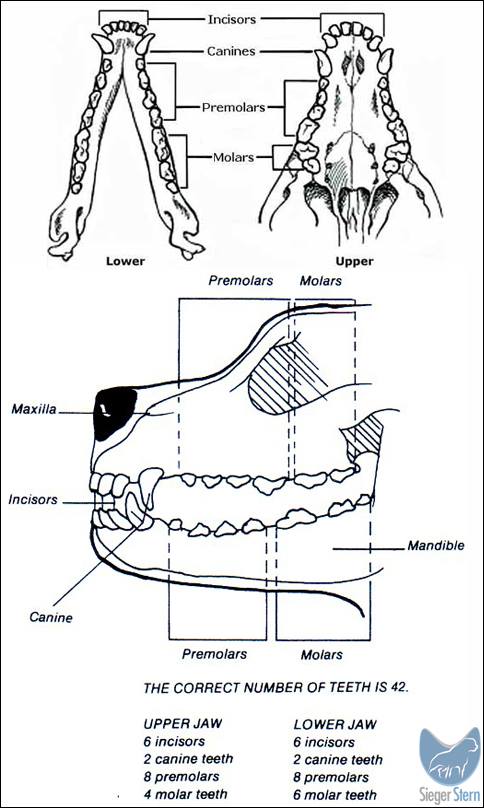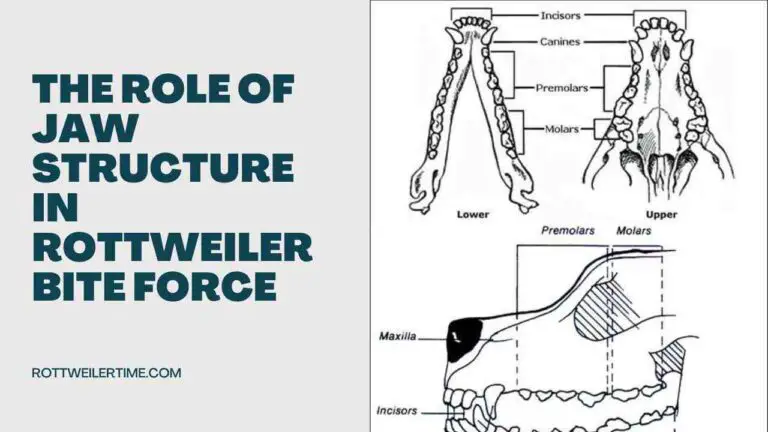In the world of dog breeds, Rottweilers stand out for their impressive strength and powerful bite force. These robust canines have a distinct jaw structure that contributes to their biting capabilities.
Understanding the role of jaw structure in Rottweiler bite force can shed light on their unique abilities and highlight the importance of responsible dog ownership. In this article, we delve into the intricate details of Rottweilers’ jaw structure and its impact on their bite force.
Contents
- 1 Anatomy of the Rottweiler Jaw
- 2 1. The Mandible and Maxilla
- 3 2. Dentition and Dental Formula
- 4 3. Skull Structure
- 5 Mechanics of Rottweiler Bite Force
- 6 1. Muscles and Tendons
- 7 2. Bite Pressure
- 8 3. Bite Style
- 9 Influencing Factors
- 10 1. Genetics and Breed Standards
- 11 2. Training and Conditioning
- 12 Responsible Ownership and Safety
- 13 FAQs
- 14 Conclusion
Anatomy of the Rottweiler Jaw
1. The Mandible and Maxilla
The Rottweiler’s jaw is composed of two main bones: the mandible (lower jaw) and the maxilla (upper jaw). These bones are tightly connected and form a solid framework that supports the dog’s teeth and muscles involved in biting.
2. Dentition and Dental Formula
Rottweilers possess a strong set of teeth that are crucial for their bite force. Their dental formula consists of 42 teeth, which include incisors, canines, premolars, and molars. The canines, in particular, play a vital role in biting and holding onto objects with exceptional force.
3. Skull Structure
The skull structure of Rottweilers contributes to their bite force as well. The skull is broad and robust, providing ample space for the attachment of powerful jaw muscles. The zygomatic arch, also known as the cheekbone, further enhances the strength of the jaw by allowing better leverage during biting.

Mechanics of Rottweiler Bite Force
1. Muscles and Tendons
The jaw muscles of a Rottweiler are exceptionally well-developed, enabling them to exert immense force while biting. The masseter and temporalis muscles, in particular, are responsible for generating substantial pressure when the jaws close. These muscles work in harmony with tendons, allowing precise control and exertion of force.
2. Bite Pressure
Rottweilers are known for their remarkable bite pressure, which can be attributed to the combination of jaw structure and powerful muscles. Studies have shown that Rottweilers can exert a bite force of around 328 pounds per square inch (PSI) on average. This formidable bite strength is significantly higher than that of many other dog breeds.
3. Bite Style
Apart from their bite force, Rottweilers also exhibit a specific bite style. They possess a “full mouth” bite, meaning they can close their jaws around an object or prey with a wide grip. This bite style allows them to distribute force evenly across their teeth, maximizing their bite’s effectiveness.
Influencing Factors
1. Genetics and Breed Standards
The jaw structure and bite force of Rottweilers are influenced by genetic factors. Responsible breeders aim to maintain the breed’s standards, including appropriate jaw structure, to preserve their unique characteristics. Selective breeding can enhance desirable traits related to bite force, ensuring the continuation of Rottweilers’ remarkable biting capabilities.
2. Training and Conditioning
While genetics play a significant role, proper training and conditioning are crucial in harnessing a Rottweiler’s bite force effectively. Professional obedience training and controlled exercises can help develop the dog’s bite inhibition and improve its responsiveness to commands, ensuring a well-balanced and disciplined companion.
Responsible Ownership and Safety
Rottweilers’ formidable bite force demands responsible ownership and an understanding of their unique traits. Here are some important considerations:
- Socialization: Early socialization is key to raising a well-adjusted Rottweiler. Proper exposure to various environments, people, and animals helps reduce the risk of aggressive behaviors.
- Training: Consistent and positive reinforcement training is essential for shaping a Rottweiler’s behavior. Teaching commands like “leave it” and “drop it” can prevent potential biting incidents and promote better control.
- Supervision: It’s important to supervise interactions between Rottweilers and other animals or unfamiliar individuals, especially in public spaces. This ensures the safety of everyone involved and prevents any potential accidents.
- Secure Enclosures: Providing a secure and appropriate enclosure for your Rottweiler is vital. A sturdy fence and a well-maintained yard can prevent escapes and protect your dog from potential hazards.
- Leash Control: When outside the confines of your property, always keep your Rottweiler on a leash. This not only ensures their safety but also helps maintain control in public spaces.
FAQs
Are Rottweilers more prone to aggressive behavior due to their strong bite force?
While Rottweilers possess a powerful bite force, aggression is not solely determined by bite strength. Proper socialization, training, and responsible ownership play a significant role in shaping a Rottweiler’s behavior. With the right upbringing and care, Rottweilers can be friendly, well-behaved dogs.
Can the jaw structure of a Rottweiler be influenced by diet?
A well-balanced diet contributes to overall health, including the development of strong bones and muscles. Providing a nutritious diet rich in essential nutrients can support optimal jaw structure development in Rottweilers.
How can I safely measure my Rottweiler’s bite force?
Measuring bite force should only be done by professionals in controlled environments. Attempting to measure bite force without proper expertise and equipment can be dangerous and may lead to injuries.
Can jaw structure affect a Rottweiler’s chewing habits?
Yes, a Rottweiler’s jaw structure can influence its chewing habits. With their strong jaws, Rottweilers are capable of chewing on tougher objects. Providing appropriate chew toys and bones can help satisfy their natural chewing instincts and promote dental health.
Are there any specific exercises to strengthen a Rottweiler’s jaw muscles?
Consulting with a professional dog trainer or veterinarian is recommended when it comes to exercises to strengthen a Rottweiler’s jaw muscles. They can provide guidance on safe and effective exercises tailored to your dog’s needs.
Conclusion
The jaw structure of Rottweilers plays a significant role in their impressive bite force. Their well-developed jaw muscles, dental composition, and robust skull structure all contribute to their biting capabilities. Understanding the unique characteristics of their jaw structure highlights the importance of responsible ownership and proper training to harness their power effectively. By promoting responsible ownership and providing appropriate care, we can ensure that Rottweilers thrive as loyal companions while also prioritizing safety.
Meet the Author Mehmood Shah,
As an owner of Rottweiler for 10 years, I motivate and encourage people about this lovely breed.
We’re dedicated to providing you the detailed researched articles about Rottweiler, with an emphasis on Rottweiler Health, Training, and Exercises.
I started my journey with Rottweiler Time in 2021 and it has come a long way from its beginnings.
Thanks for Your Support.


